The system is great with passive pickups that do not benefit from the subtle treble roll-off that, eliminating cable tone simulation, this model removes. You can establish a connection with as many as 14 Boss wireless systems, juggling more instruments without replacing the system.
The transmission range is limited.
Acoustic, electric, and bass guitars with an onboard preamp will benefit immensely from the Boss WL-20L Wireless Guitar System. Line-level instruments (such as keytars and digital wind devices) where cable capacitance has little or no effect on the tone will also work great with this system.
2.4 GHz
Up to 50 feet
2.3 ms
20 Hz - 20 kHz
110 dB
Receiver: 1/4" TRS output plug, 1/4" TRS TRANSMITTER jack, Micro USB (for charging)
Transmitter: 1/4" TRS input plug, Micro USB (for charging)
Rechargeable battery (transmitter and receiver)
Charging USB cable included
1 year
The H1 transmitter holder makes the system compatible with unorthodox guitar jacks. The holder distances the transmitter from the guitar's battery, solving high-frequency noise problems that you sometimes get from active pickups.
The batteries do not necessarily last.
The Xvive U2 Wireless Rechargeable Guitar System is made from sturdy ABS plastic. The system pretty much matches the sound quality that you get from cables but without making the rig cluttered. Plus, even inexperienced guitarists should be able to figure out this system without following instructions.
2.4 GHz
More than 70 feet
5 ms
20 Hz - 20 kHz
103 dB
Receiver: 1/4" TRS output plug, Micro USB (for charging)
Transmitter: 1/4" TRS input plug, Micro USB (for charging)
Rechargeable battery (transmitter and receiver)
Charging USB cable included
1 year
You can rotate the heads 180 degrees, working with different sockets at various positions. Keeping the highs sharp and the lows creeping, the system makes sure that the music sounds deep and accurate, matching the tonal balance that you usually get from cables.
The latency is pretty noticeable.
The Getaria GWS-8 will be able to accommodate beginners looking to ditch the cables. With the system's dynamic range reaching 105 decibels, you're able to play at the highest volume without noticeable quality loss. What's more, the system can support six devices at a time.
2.4 GHz
Up to 98 feet
12 ms
20 Hz - 20 kHz
105 dB
Receiver: 1/4" TRS output plug, Micro USB (for charging)
Transmitter: 1/4" TRS input plug, Micro USB (for charging)
Rechargeable battery (transmitter and receiver)
Charging USB cable included
Amazon's 30-day return policy
The 1100-mAh batteries will give you ~8 hours of continuous playing. The batteries can also be fully recharged in 90 minutes. Working within the standard 20 Hz – 20 kHz range, the system makes sure that the sound comes out without noticeable distortion or deviation.
The 1/4" output plugs are stiff initially.
Newbies, enthusiasts, pros, veterans, they can all benefit from Mefe MF-5G Wireless Guitar System. Acting on the 5.8 GHz band, this system lets you jam even while surrounded by Wi-Fi routers, extenders, countless interference sources without worrying about signal quality.
5.8 GHz
Up to 98 feet
5.6 ms
20 Hz - 20 kHz
105 dB
Receiver: 1/4" TRS output plug, Micro USB (for charging)
Transmitter: 1/4" TRS input plug, Micro USB (for charging)
Rechargeable battery (transmitter and receiver)
Charging USB cable included
2 years
With the maximum available frequency response that the system can maintain reaching 22 kHz, this system delivers consistent non-screaming highs. The bass output is full and impactful, with a clean yet dynamic thump. The sound flow on high volumes is detailed and without drop-outs/squelching.
The USB cable that comes with the package is flimsy.
Minimizing latency, sporting an awesome vintage design with an elegant cherry wood finish, and ensuring excellent sound, this system from Ammoon is not to be trifled with. Plus, you can rotate the connection jacks ~220 degrees, enabling various connection angles.
5.8 GHz
More than 100 feet
6 ms
10 Hz - 22 kHz
110 dB
Receiver: 1/4" TRS output plug, Micro USB (for charging)
Transmitter: 1/4" TRS input plug, Micro USB (for charging)
Rechargeable battery (transmitter and receiver)
Charging USB cable included
Amazon's 30-day return policy
This site is a free online resource that strives to offer helpful content and comparison features to its visitors. Please be advised that the operator of this site accepts advertising compensation from certain companies that appear on the site, and such compensation impacts the location and order in which the companies (and/or their products) are presented, and in some cases may also impact the scoring that is assigned to them. The scoring that appears on this site is determined by the site operator in its sole discretion, and should NOT be relied upon for accuracy purposes. In fact, Company/product listings on this page DO NOT imply endorsement by the site operator. Except as expressly set forth in our Terms of Use, all representations and warranties regarding the information presented on this page are disclaimed. The information which appears on this site is subject to change at any time. More info
Boss WL-20L
Eliminating Cable Tone Simulation
Going cable-free can be difficult. With the Boss WL-20L, the task is anything but difficult. Purchasing this system, you can wave cable management woes goodbye. Docking the transmitter and receiver together (wait about 10 seconds) is all that's required with this system to automatically set an optimum connection. In other words, plug and play, removing complicated setup, tone loss, and bulky adds-ons from the equation. When you dock them, the integrated batteries inside the transmitter and receiver can be charged together via standard USB adaptors (5 V/500 mAh or more) that you charge smartphones/tablets with. Of course, you can also charge them separately.
Hanging with the Boss WL bunch, this system is almost indistinguishable from the WL-20 model aside from cable tone simulation that the subject system eliminates. With this approach, the WL-20L will be at its best working with instruments where cable capacitance has limited or no effect on the tone (like acoustic or electric guitars with an onboard preamp or line-level devices like keytars and digital wind instruments. What's more, the model is awesome with passive pickups, assuming that you do not require the subtle treble roll-off that cable tone simulation can provide.
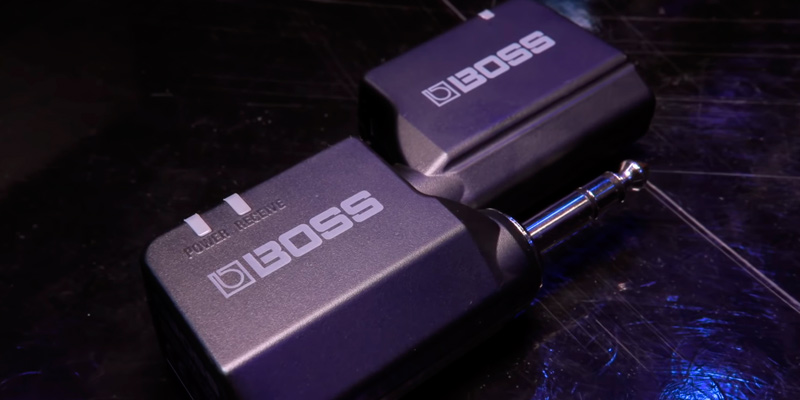
Ultra-Low Latency
The system has its limits, they all do. This time, the transmission range caps at 50 feet, which is not terrible and, truth be told, you seldom need more than that, but there are less expensive models that expand the transmission range 70-100 feet, meaning that this is an area where we would like to see some improvement next time.
On the massive upside, an area that does not require improvements at all is the latency. Capping at 2.3 milliseconds, the ultra-low latency that this system brings will be unnoticeable. Meanwhile, the expansive dynamics will ensure outstanding audio performance and rock-solid stability.
Recharging the transmitters and receivers that constitute wireless guitar systems can be a drag. With this system stretching the integrated batteries' continuous use 10 hours, you'll be able to jam with friends, prepare, and perform on stage without worrying that the charge will not cut it.
Last but not least, with this model, you'll be able to use up to 14 Boss wireless systems at the same time in one space, so you can juggle more instruments without replacing the system. To sum up, again, people who play acoustic guitars, acoustic-electric guitars, bass guitars, and line-level instruments do not want to miss this system from Boss.

Additional Info
| Last updated price | $205.99 |
| Stock | In stock |
| ASIN | B07F2PY7DD |

Xvive U2
Tough Build with Premium Audio Quality
The Xvive U2 Wireless Rechargeable Guitar System lets you ditch cables and make the rig look nice and clean, not unlike its competition. What the model's competition is seldom bringing to the table though is the H1 transmitter holder, making sure that the system is always compatible with guitar jacks. Distancing the transmitter from the battery in the guitar, the holder also solves high-frequency noise problems that active pickups sometimes entail.
From the get-go, this system is promising awesome audio quality and almost undetectable latency (5 milliseconds). From what we can tell, the system fulfills the promise to a tee, removing drop-out and working without noise or delay, almost like you're using cables, except that you aren't.
Unboxing the package, the first thing you'll notice is that both the transmitter and the receiver look and feel sturdy and well-made, primarily from ABS plastic. The swivel mechanism on the plugs is stiff but not too stiff, meaning that pivoting the system into position will be easy but, once you do that, the plug will stay where you put it. To prevent scratches, there's also soft rubber padding on the back.
On one side, you will find a power switch, the channel-change button, and two LEDs. The first LED displays the battery status and lets you know when the system is on and off. The second LED shows you the channel you're using and whether the two units have been synched.
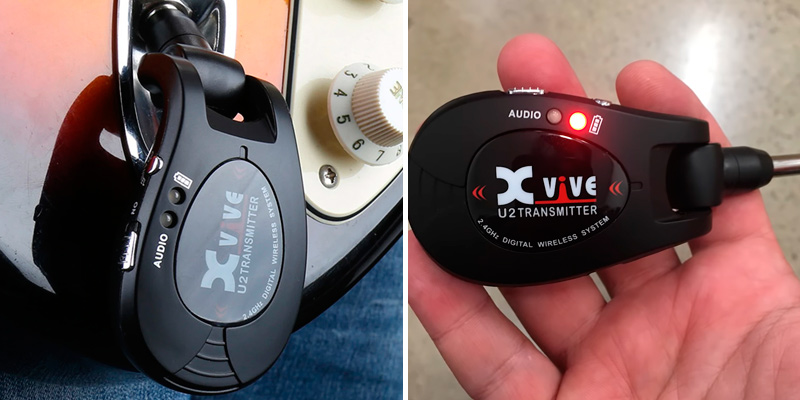
Identical Waveforms
Sound quality is subjective. Having said that, the fidelity difference is basically nonexistent here. Recording with DAW, the waveforms between the ones that this system produces and the ones you get from cables will look pretty much identical. Sure, some might feel the slightest reduction at the extreme frequency spectrum ends but this is not something that even trained ears will be able to pick up.
Likewise, with the latency capping at 5 milliseconds, the delay is virtually undetectable. The people behind this model are claiming that the transmission range will be able to cover at least 70 feet and they can back up that claim, even with multiple obstacles (walls, furniture, even cars) between you and the receiver.
Long story short, the Xvive U2 Wireless Rechargeable Guitar System can be used straight from the box without reading the instructions. The system offers great build quality, great sound quality, and the usual convenience that you receive when you go wireless.
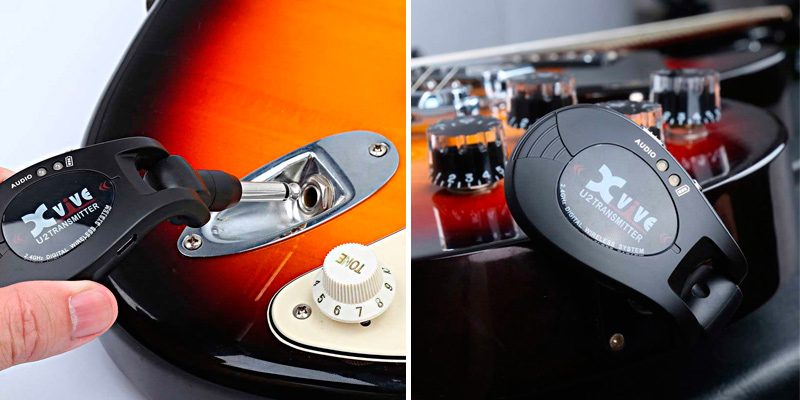
| Last updated price | $154.90 |
| Stock | In stock |
| ASIN | B01N4DSQBR |
What customers say about this product
Features
Key Specs
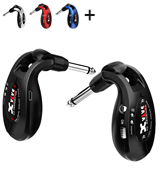
Getaria Built-in Rechargeable Lithium Battery
Full and Accurate Sound
The Getaria GWS-8 is a decent system that will accommodate beginners but not always the more experienced guitarists. The signal that both the transmitter and the receiver are offering is strong, enabling interference-free sound. But, at extreme volume and frequency limits, the noise becomes noticeable. Faint, but noticeable. Also, the model cannot promise latency below 12 milliseconds, so the delay will also be faint but noticeable.
That being said, aside from extreme cases, the sound will usually be transferred without substantial lag, remaining crisp even when you start playing complex compositions incorporating hard riffs as well as multiple variations. There's no tone or detail loss. The highs that are transferred through this system remain sharp, while the lows are as solid and creeping as they should be. Generally speaking, the music will sound full and accurate, with a good tonal balance that you normally get from cables. To add more, with the dynamic range exceeding 105 decibels, you can play at the maximum volume without quality loss.
Build-wise, both devices are pocket-sized, enabling comfortable transportation. They're made primarily from food-grade plastic, making the system pretty tough as well. What's more, the heads can be rotated 180 degrees, offering easy maneuvering. Both the transmitter and the receiver come equipped with 1100-mAh rechargeable batteries, so they should usually last at least 8 hours on a single charge.

Six Devices at any One Time
At this price point, there are no miracles, meaning that the system makes a few questionable moves as well. The LED lights that start glowing once the devices are paired are bright and distracting. While the construction is generally sturdy, the USB ports are fragile, so proceed with caution when you recharge these devices.
On the plus side, the system comes with an integrated memory function, storing the previous pairing and ensuring automatic connection next time. In fact, with this system, six devices can be supported at any one time, so you can switch between multiple instruments and juggle even more equipment than necessary. Finally, the signal transfer length usually reaches 100 feet, working through walls as well, though such obstacles reduce the distance to ~40 feet.
Bottom line, while 'purist' players might feel cheated with this system, the Getaria GWS-8 more than covers beginners' needs, ensuring respectable frequency response throughout the entire range and maintaining excellent tonal balance.
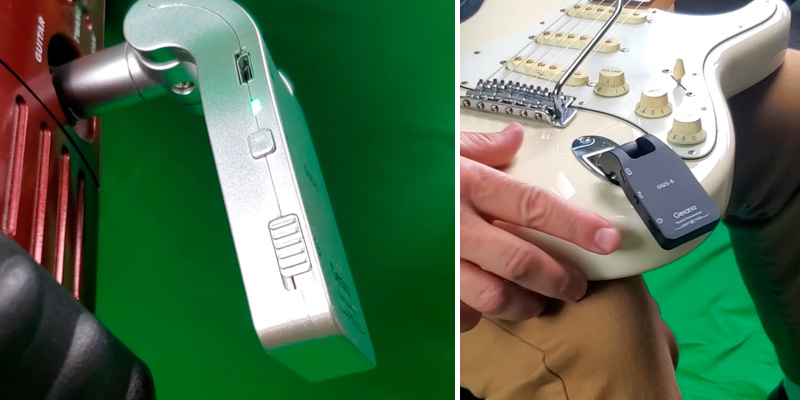
| Last updated price | $39.99 |
| Stock | In stock |
| ASIN | B07L5B64RG |

Mefe 5.8GHz Rechargeable
No Distortion or Deviation
The Mefe MF-5G Wireless Guitar System will be appreciated by newbies and professional players alike. Offering high-quality sound transmission, solid 'throw' distance, as well as above-average battery life, this is not the system that you can take for granted.
Sure, output plugs are not great here. To elaborate, some guitars will not always be able to accommodate the entire jack, leaving the receiver basically flapping around the guitar. With the transmitter protruding behind the edge of the guitar, there's an actual risk that you might hit it against the leg and unplug. Nevertheless, considering the model's specs, we can forgive the subpar jacks.
First and foremost, these specs include both devices (the transmitter and the receiver) acting on the 5.8 GHz band, meaning that most interference sources will not be able to interfere with the signal. More than that, you can choose between 4 working channels, ensuring noise-free signal passthrough.
As you would expect, the system is able to capture the full signal within the standard 20 Hz – 20 kHz range, so that the sound coming from the amp is always well-composed, crisp, and sharp. Generally speaking, there's no noticeable distortion or deviation. The overall harmonical composition's usually transmitted with precision. The highs remain clean, consistent, and well-balanced, the mids come out expansive, detailed, and dynamic, the lows always have noticeable separation, and the bass output has respectable impact and above-average extension. All that being said, there's a slight tone coloration, but nothing that interferes with the overall output.
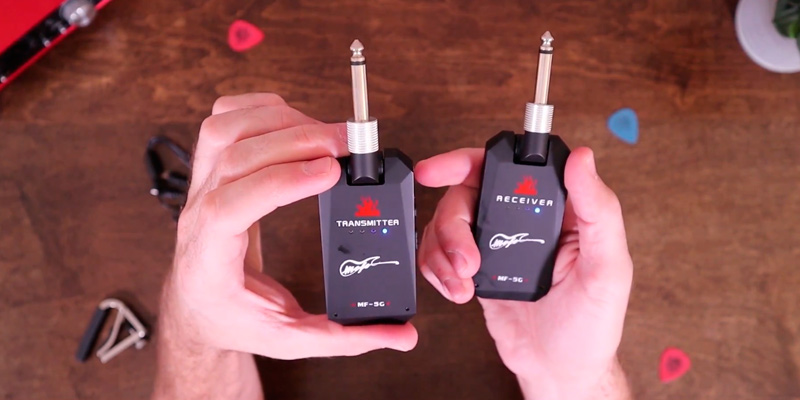
90-Minute Recharge
The operating distance with this system is tricky. Without obstacles, the transmission range covers ~100 feet with relative ease. But the signal's not great with obstacles, sometimes halving the range, sometimes even capping at 30-35 feet. The good news is that, while the optimal signal quality is usually reached within ~30 feet from the receiver, there's no noticeable latency or noise until you start reaching the limit.
As always, the performance quality will depend on the battery state (the highest at full charge), which is not an issue here since the 1100-mAh batteries can enable continuous playing for ~8 hours straight. Even more attractive is the fact that they can go from 0 to 100% in 90 minutes, so you even recharge them right before the sesh knowing that the battery will pull through.
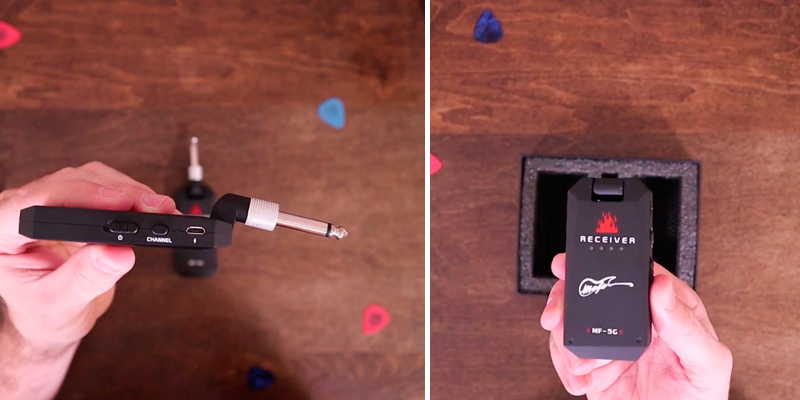
| Last updated price | $0.00 |
| Stock | May be out of stock |
| ASIN | B07Y2S4VLX |

Ammoon 5.8 Ghz
Clean Dynamic Thump
Solid working distance, high dynamic range, and extended frequency response are the reasons why professionals hold this wireless guitar system from Ammoon in the highest regard. That being said, the system fits amateurs about as much as pros. We could have even called this model the best wireless guitar system on the market today but, with sustained notes featuring some digital interference, especially at low volume, the output feels and sounds a little compressed, so no dice, not quite. Nevertheless, this is one awesome system.
To start with, the model's tuned to work on the 5.8 GHz band, contributing the least affected signal transmission. Sure, with Wi-Fi routers sitting close to the set, you might feel a slight buzz, but the sound will not be distorted via nearby radio waves or mobile connections. Furthermore, the system stretches the transmission range above 100 feet, so you're free to move around while playing. When you face an occasional interference issue, you can switch between the 4 channels that the system maintains.
From the performance perspective, the system converts the sound into 24-bit resolution waves on 48 kHz frequency, making the output crisp and clean. What is more, owing to the maintained frequency reaching 22 kHz, the model ensures non-screaming consistent highs. While this is happening, the bass comes out full and punchy, with the cleanest dynamic thump that wireless systems can provide, enabling a crisp output. The maintained frequency range reaches 22 kHz providing non-screaming consistent highs. Wrapping the performance subject, with the dynamic range limited at considerable 110 decibels, the system offers a pretty detailed sound flow on high volumes without introducing drop-outs or squelching issues.
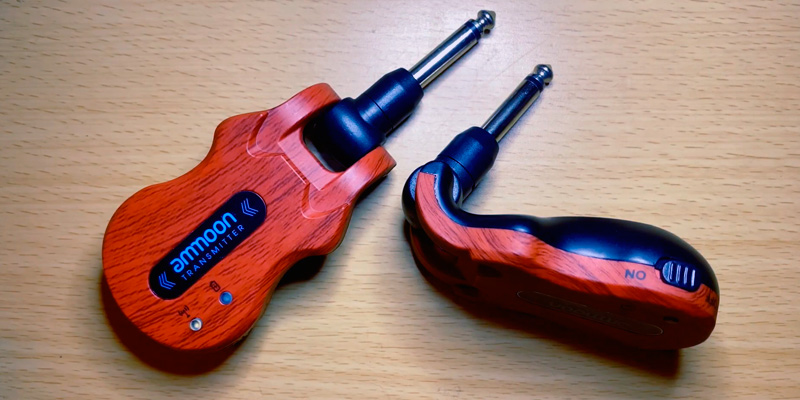
Going Vintage
From an appearance angle, we seldom care what transmitters and receivers look like but we can at least appreciate the vintage design that these devices are sporting, separating them from standard, modern-looking alternatives. We can also appreciate the connection jacks that can be rotated ~220 degrees, enabling different connection angles. Apart from that, the pairing part is quick and trouble-free, performed automatically when you turn both items on. Finally, the LED lights will display the battery status and the connection/signal strength.
In short, the Ammoon 5.8 GHz Wireless Guitar System minimizes latency, sports an aesthetically pleasing design, enables simultaneous receiver and transmitter charging through the supplied dual USB cable, and ensures excellent sound.

| Last updated price | $0.00 |
| Stock | May be out of stock |
| ASIN | B07MC7ZW9T |
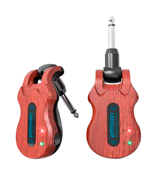
What Is a Wireless Guitar System?
Jamming with friends, experimenting at home, having a blast on stage, you can do so much with guitars, and they ask so little in return. Besides the obvious maintenance demands, guitars usually like when you make the connection as wireless as possible, hence these wireless guitar systems.
With these systems, you can move around without worrying that you might snag or unplug something, damaging the instrument or the equipment piece that you were working with. Of course, just a few years ago, decent wireless systems used to cost an arm and a leg and the systems that were affordable introduced noticeable latency, meaning that even the least talented and experienced musicians could tell that there's a delay between the amp and the instrument.
Nowadays though, there are adequate systems that cost below 50 bucks. Despite the almost laughable price, the receivers and transmitters that these systems are using reduce lag, eliminate noise, sure interference-free transmission, and make the output indistinguishable from the one that even the best wires are offering. Plus, the batteries inside these systems can usually work for ~8 hours straight on a single charge.
What Features to Compare
Wireless Carrier Frequency
Wireless guitar systems act on 2.4 GHz and 5.8 GHz bands. More often than not, the second option is the more preferable one since this is also the less occupied one. The potential interference sources on this band are reduced. Still, this will depend on the electronics surrounding you. Assuming that you're surrounded with multiple Wi-Fi routers or extenders that operate on the same band, you receive nothing but disadvantages from the second band.
Transmission Range
Wireless devices always have a limited signal transfer length. With the transmitters and receivers that constitute wireless guitar systems, the range usually hovers around 50-100 feet. As always, obstacles between you and the receiver can reduce the maximum available distance, sometimes substantially (50-100%), sometimes not quite as much.
Frequency Response
People who have hung around audio circles long enough inevitably come across the term frequency response. This is a loaded subject that we will not be explaining at great length here. In short, frequency response measures how good particular audio components are at reproducing audible frequencies within the advertised response. Setting aside deliberate EQ tweaks, perfect frequency output should be equal to the input. Otherwise, the signal is altered. The people around in the audio circles call this response 'flat', where fixed volume sine waves can be swept through the system and maintain the same amplitude at all frequencies at the output.
Since human hearing ranges from 20 Hz to 20 kHz, that's the response that most musical equipment pieces are covering. That said, while you might not be able to hear them, the frequencies above 20 kHz can add transience and rumble to the sound, making the music feel more impactful. Plus, without that inaudible range, the music can sometimes sound artificially closed-off.
Dynamic Range
Avoid systems that are not offering above 100 decibels on the dynamic range scale at all costs. Without exceptions, these systems make the sound flow blurry and inconsistent on high volumes. Adding insult to injury, they usually introduce drop-outs and squelching issues.
Extras
Setting aside performance, there are multiple factors contributing to increasing or decreasing wireless guitar systems' value. These include battery life (as well as the time the battery takes to go from 0 to 100%), input plugs, the ports, and the cables that usually come with the system.
Wired vs Wireless: Should You Lose the Cables?
Going cable-free or sticking with what's working is a much-debated topic among guitarists. While both affect the tone, this issue is more about application and signal flow. So, what are the upsides and downsides that both approaches entail?
Wired
With cables, screening is everything. Cheap cords will always introduce unwanted noise and buzz, so you need something with decent shielding. Shielding the conductors against electrical interference (using metal shields, plastic jackets, and insulation), high-quality cables are able to minimize noise. Still, when cables are unbalanced, you cannot escape the noise, so keep the cables away from potential interference sources (power supply units, radios, Wi-Fi routers, etc).
Second, do not forget capacitance. In a nutshell, capacitance is the cables' ability to store an electrical charge. With high-impedance equipment (like passive guitars), low capacitance gives you an improved frequency response. But, the longer the cable is, the higher is the capacitance and signal loss across its length. In other words, stick with the shortest cables that you can work with.
The last guest at this party is connectors. Needless to say, anything standing between you and the amp will have an effect on the sound quality, including connectors. This is not the most difficult part though. As long as you go with gold-plated connectors, you'll be fine since gold is an excellent electricity conductor. Also, gold-plated connectors do not corrode with time.
Wireless
The biggest issue with wireless systems is that the cheap ones are always coloring the tone. Working with companders that have a fixed ratio, they can make the output sound quite unnatural. These are not the systems that we're discussing here though. No, the systems that we've reviewed above come equipped with natural-sounding companders, so the difference between wired and wireless outputs becomes almost or, at times, 100% undetectable.
Cheap wireless systems are not an option. When you're on a strict budget, go with cables. That being said, these systems are becoming more and more affordable nowadays, so there are models that cost less than 50 bucks and sound almost indistinguishable from a wired connection. But, unlike with wires, these systems let you move around the stage as much as you want. As long as the AD/DA converters are good enough, the original tone will be maintained, and the output will sound completely natural.
Conclusion
Again, the 'application' part is everything here. Where you play, with whom you play, the frequency with which you travel, what the stages look like, and more, these factors will determine whether you should go cable-free or remain wired. Assuming that you have the financial means, we will recommend going wireless. Beginners and intermediate players can seldom tell the difference between the two anyway, so you might as well stick with what's more comfortable and convenient, which is always wireless systems more so than wired systems.


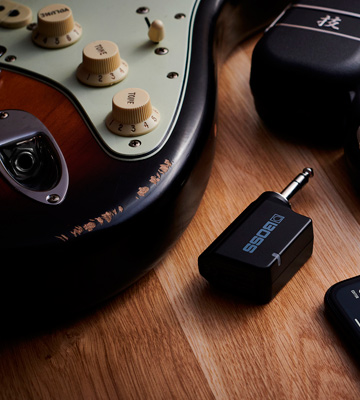
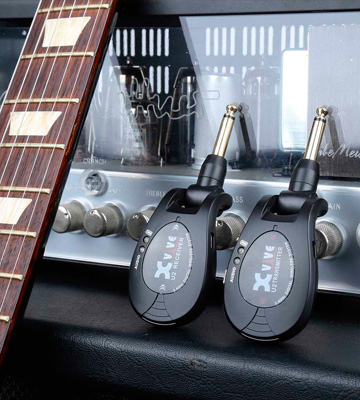

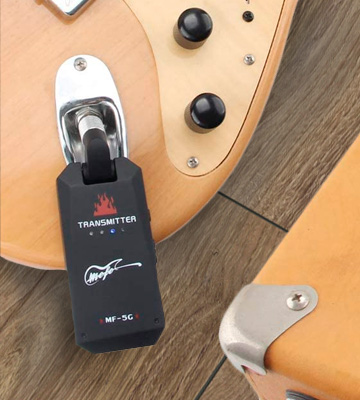
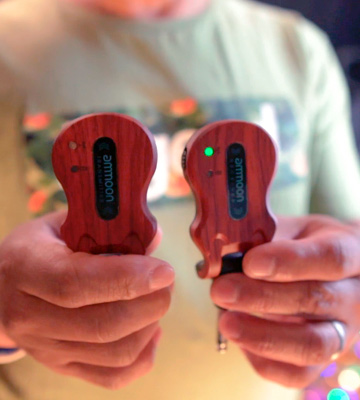

Your comment was successfully sent
Error! Please try again later